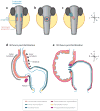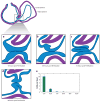Uncovering the molecular and cellular mechanisms of heart development using the zebrafish
- PMID: 22974299
- PMCID: PMC6982417
- DOI: 10.1146/annurev-genet-110711-155646
Uncovering the molecular and cellular mechanisms of heart development using the zebrafish
Abstract
Over the past 20 years, the zebrafish has emerged as a powerful model organism for studying cardiac development. Its ability to survive without an active circulation and amenability to forward genetics has led to the identification of numerous mutants whose study has helped elucidate new mechanisms in cardiac development. Furthermore, its transparent, externally developing embryos have allowed detailed cellular analyses of heart development. In this review, we discuss the molecular and cellular processes involved in zebrafish heart development from progenitor specification to development of the valve and the conduction system. We focus on imaging studies that have uncovered the cellular bases of heart development and on zebrafish mutants with cardiac abnormalities whose study has revealed novel molecular pathways in cardiac cell specification and tissue morphogenesis.
Figures


References
-
- Alexander J, Rothenberg M, Henry GL, Stainier DY. Casanova plays an early and essential role in endoderm formation in zebrafish. Dev Biol. 1999;215(2):343–57. - PubMed
-
- Alexander J, Stainier DY, Yelon D. Screening mosaic F1 females for mutations affecting zebrafish heart induction and patterning. Dev Genet. 1998;22(3):288–99. - PubMed
-
- Arrenberg AB, Stainier DYR, Baier H, Huisken J. Optogenetic control of cardiac function. Science. 2010;330(6006):971–74. - PubMed
Publication types
MeSH terms
Grants and funding
LinkOut - more resources
Full Text Sources
Molecular Biology Databases
Miscellaneous

